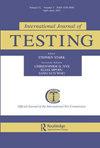The analysis of TIMSS 2015 data with confirmatory mixture item response theory: A multidimensional approach
IF 1.4
Q2 SOCIAL SCIENCES, INTERDISCIPLINARY
引用次数: 0
Abstract
AbstractIn this study, we illustrated an application of the confirmatory mixture IRT model for multidimensional tests. We aimed to examine the differences in student performance by domains with a confirmatory mixture IRT modeling approach. A three-dimensional and three-class model was analyzed by assuming content domains as dimensions and cognitive domains as item groups. We estimated the item performance differences among the students through structural parameters. There were 463 students from Turkey and 880 students from Canada who participated in the TIMSS 2015 4th-grade mathematics assessment. Results for Turkey indicated, students in Class 2 had better performance in knowing and reasoning compared to those in Classes 1 and 3. Students in Class 2 and Class 3 were similar in applying math concepts compared to students in Class 1. For the Canadian sample, students in Class 2 had better performance in knowing, applying, and reasoning compared to those in Class 1 and 3. Also, Class 3 students were better at applying domain than Class 1. Also, mean values were obtained for all content domains in the two countries. Confirmatory mixture IRT modeling approaches appear to differentiate students’ mathematics competencies.Keywords: Confirmatory mixture IRT modelinglatent classmultidimensional modelTIMSS 2015验证性混合项目反应理论对2015年TIMSS数据的多维分析
摘要在本研究中,我们展示了验证性混合IRT模型在多维测试中的应用。我们的目的是通过验证性混合IRT建模方法来检查不同领域学生表现的差异。以内容域为维度,认知域为项目组,分析了三维三类模型。我们通过结构参数来估计学生之间的项目绩效差异。有463名土耳其学生和880名加拿大学生参加了TIMSS 2015年四年级数学评估。结果显示,土耳其2班学生的认知和推理能力优于1班和3班学生。二、三班学生在应用数学概念方面与一班学生相似。在加拿大的样本中,2班的学生比1班和3班的学生在认知、应用和推理方面表现更好。此外,三班学生在应用领域方面也优于一班。此外,还获得了两国所有内容域的平均值。验证性混合IRT建模方法似乎可以区分学生的数学能力。关键词:验证性混合IRT模型;潜在分类;多维模型
本文章由计算机程序翻译,如有差异,请以英文原文为准。
求助全文
约1分钟内获得全文
求助全文
来源期刊

International Journal of Testing
SOCIAL SCIENCES, INTERDISCIPLINARY-
CiteScore
3.60
自引率
11.80%
发文量
13
 求助内容:
求助内容: 应助结果提醒方式:
应助结果提醒方式:


